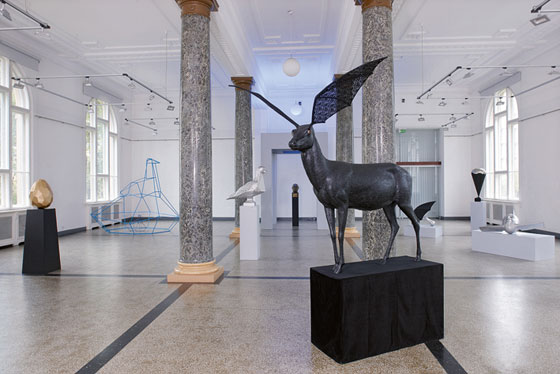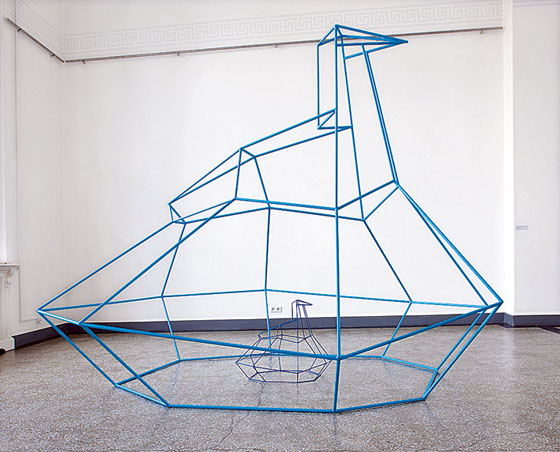|
|
| About flying Stella Pelše, Art Historian Gļebs Panteļejevs. OrNiTHOLOGY 09.09.–23.10.2011. Latvian National Museum of Art, the White Hall | |
| Sculpture exhibitions do not take place in the White Hall of the National Museum that often – especially if the author is one of the most recognized and popular sculptors who has had equal success in both public art and monumental works, as well as on the scale of what used to be called figural objects, also dipping into the sphere of contemporary art. The artist is an associate professor at the Latvian Art Academy, has held ten personal exhibitions, participated in numerous sculpture events in Latvia and abroad, received awards and prizes in sculpture competitions, has been able to find means of expression which reconcile the admirers of the traditional “hero on horseback” style with those who seek a more abstract and modern form (the commemorative plaque ‘The Black Threshold’ at the former KGB building in Stabu iela (2003), the memorial to Oskars Kalpaks on Riga Esplanāde (2006), and others). One of the more recent solo exhibitions which may have stayed in the memory of conscientious art lovers was Miglas Zona (‘Mist Zone’), held in 2007 at the Riga Gallery, where a tank with caterpillar tracks made out of carpet Austrumu tepiķis (‘Eastern Carpet’) coexisted with a surreal melting into shapelessness of various items – an eye, a car (‘Mist Zone I’, ‘Mist Zone II’) and a surprisingly realistic portrayal of a blue-eyed old woman in Rudzu puķes (‘Cornflowers’). The creative quest from the depiction of mist in metal to a certain hyperrealism in the art of Panteļejevs does not conflict with the specific requirements of commissioned work, testifying to the viability of sculpture as an art form even outside the aegis of Soviet ideology. As curator Gundega Cēbere says in the annotation to the exhibition, “In the field of sculpture today Gļebs Panteļejevs stands out with plasticity of form, emotional and philosophical compositions, the use of non-traditional materials – ones not often used for sculpture but appropriate to the chosen idea, and skilful workmanship.” | |
 The view from the Gļebs Panteļejevs' solo exhibition 'OrNiTOLOGY' | |
| The most attractive embodiment of unusual materials that immediately on entering drew the attention of the considerable crowd of viewers who had come to the opening of the show was definitely Melanholiskais valsis (2011) – a majestic stuffed black stag with lacework bat wings attached to its head. Do four-legged creatures, who only know how to run, dream about flying? This is a question that probably cannot be answered by present-day scientific methods. But why wouldn’t they? The hybrid, impossible creature seems to be at the same time closest of all to the tradition of ready-mades and doesn’t even seem to demonstrate any specifically “sculptural” features. The most important thing here is the idea, encoded in the visual image and the way it is displayed. The title of the exhibition, which can be read in two ways – ‘Ont-(h)ology’ (the study of the nature of existence) and ‘Ornithology’ (the study of birds) with its dropped out but nevertheless visible “r” and “i” – allows one to bounce back and forth between philosophy and biology, thus leading to the inevitable problem of the relationship between the spiritual and the material. If the ornithologist Māris Strazds in his review was confused about the fact that “There are (almost) no birds there”(1), then, on the one hand, some of the birds are rather obvious and do not leave any doubt about their ornithological origins. For example, Privātums (‘Privacy’, 2011), a formation of steel wires with a smaller bird inside a larger one – not so much privacy here, though, as this work is an excellent example of the 20th century transformation of sculpture from the traditional monolithic volume to a drawing in space. The aluminium sculpture Ledlauzis (‘Icebreaker’, 2009) is also in the unmistakable shape of a bird. It is perforated with countless little holes, maybe to make us doubt the bird’s ability to break ice with such a fragile body. On the other hand, the exhibition really isn’t about birds specifically, but rather about flying – an activity both alluring and dangerous (for those whom nature has not endowed with wings, of course). And that is a far broader field. Gaisa desants I (‘Air Strike Force I’, 2009) is surprising with its forms of the female body, but Panteļejevs does not avoid realistic portrait features either, combining a somewhat abstract approach in the spirit of modernism with a surprising attention to detail. Thus, the winged head of Ikars (2011) winks at the viewer, but the blokeish Yuri Gagarin under a fragment of blue sky in Monuments kosmosa uzvarētājiem (‘Monument to the Conquerors of Space’, 2004–2011) is executed in the tradition of the Roman realistic portrait. The sculptures are undeniably charged with definite visual associations, for example, Kupols (2009) is reminiscent of a parachute, but Antikupols (2009) is like a common grounded umbrella, under which one can hide. Then, of course, the sculptor is also interested in the egg – paradigmatic symbol of a new beginning, a purely abstract form, the perfection, smoothness and impeccability of which the author has played about with a good deal. A cracked egg, which is about to hatch a scary two-headed creature in Bizantijas dvīņi (‘Byzantium Twins’, 2011), the faceted Ola (‘Egg’, 2009), with its surface made up of numerous small platelets, and finally, 60 000 (2010–2011), an object made of polystyrene foam, textile and bamboo skewers (the title reflects the number of the skewers stuck into the egg). The huge prickly egg provokes comparisons with the nailed surfaces and their play of light and shade in the works of German artist Günther Uecker. Meanwhile in the cross-border game of postmodernist variations “how art gives rise to art” there is even an egg made of nails, in the style of Uecker, created by the Belorussian designers Vladimir Tsesler and Sergey Voichenko(2), but this is considerably more cumbersome and massive than Panteļejevs’ version. | |
 Gļebs Panteļejevs. Privacy. Steel, paint. 2011 | |
| There are also other motifs which have less to do with flying. Lāse (‘Raindrop’, 2010) is more like a mountain with a pointed peak, in this way playing on the immortalization of an elusive and evaporating object. After all, this seems to be one of the main reasons for the continued existence of sculpture – by recreating something in a “permanent” material, to see anew its transience. The partially lustrous and partially rusty two-coloured Katedrāle (2009) can inspire interesting questions about spirituality and its relationship with institutionalized religion. A building as a sculptural object (Leksikons I) was also on show in the solo exhibition Mist Zone, testifying to the author’s interest in the theme. Melns krauklis, balta kaiva (‘Black Raven, White Gull’, 2011), for those interested in the content of titles pointing to the wing construction of these very different birds, is in its essence a perfect example of abstract sculpture: a fall frozen in motion, an object which remains standing “despite” the deviation from equilibrium and the obvious dominance of the top part over the bottom part. The artist himself has commented on his creative process: “When working on a sculpture, I try to engage my subconscious. The role of modernism in the 20th century was to provide an opportunity to break loose from the rational categories of European thinking. Modernism contains an aspect of the liberated subconscious. […] But the European did not pass this test. Modernism is dead. As a doctrine. But not as a specific language of signs. It cannot die, it can only change.(3) And the search for expression by different modernist sculptors (for example, the egg-like sleeping heads of Constantin Brancusi or the oval forms with holes in them of Barbara Hepworth) has truly transformed the language into new shapes, which respond to a viewer’s longings for an eternal material (something constant against the background of consciously short-lived contemporary projects), as well as an interest in topics that are potentially exciting to everyone: overcoming gravitation, the importance of dreams, and the fallacious/unavoidable dualism of the spiritual and the material. To what extent the liberation of the subconscious plays a role here will definitely be a matter of individual experience. /Translator into English: Vita Limanoviča/ 1 Strazds, Māris. Putni pazuduši! (‘The birds have disappeared!’), Ir, 2011, No. 36, p. 31. 2 www.tsesler.com/egg/ueckeren.php 3 Slava, Laima. Gļebs Panteļejevs. Studija, 1999, No. 8, p.10. | |
| go back | |







